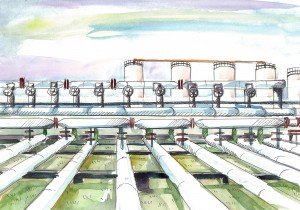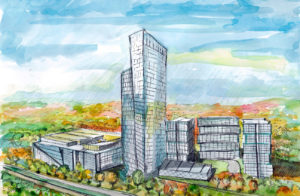The number of multifunctional buildings in Kazakhstan, which owners are two or more entities under the civil law, is growing. Such two or more owners can own small offices and whole floors. In this regard, the issue of management of common facilities in such buildings becomes topical. The concept of the condominium is aimed to solve these objectives.
Owning an office in the office building, the owner (and his visitors) uses different parts of the condominium (entrance hall, lobby, elevators, and communications). So it is fair that the owner share expenses for the upkeep and maintenance of common facilities – the Condominium, pro rata to the area of real estate owned by them. This is what the Condominium is needed for.
Multifunctional use can also deem the accommodation in the same building of living space (residential apartments with provided utilities) and non-living space (offices, hotels, cafes, restaurants, etc.) having a common utilities system.
Is there any difference in the laws of the Republic of Kazakhstan between the condominium in a residential building and the condominium in a nonresidential building? At first glance, there is no any difference.
But let’s refer to the definitions in the Civil Code of the Republic of Kazakhstan (further the CCoK).
According to the CCoK, Article 209, Item 6, "Ownership of real estate in the form of condominium arises, when parts of the real estate are in individual (separate) ownership by the individuals and/or legal entities, and those parts which are not in separate ownership belong to the owners of parts of the real estate under the right of common ownership."
As seen from the above, it is evident that in the definition of a condominium in the CCoK, there is no difference between residential properties and nonresidential properties.
Condominium refers to the joint property in the form of common ownership. Accordingly, it is governed by regulations of Chapter 11 "Common Property of the CCoK. Thus, with regard to both residential properties and nonresidential properties, the condominium has the following features and characteristics:
- The property is in common ownership with indication of each of the owners share in the property.
- Shared ownership arises when two or more entities acquire property in ownership, and this property cannot be divided without changing its intended use (indivisible things) or is not subject to division under the law.
- The share of each owner in the common property is indivisible from its separate property belonging to it.
- The share of each owner in the common property and the extent of participation in expenditures for its maintenance depend on the size of the share in the individual (separate) property, unless otherwise is provided for by legislative acts or the contract.
- Disposal of property in common ownership is carried out as agreed by all the owners of this property.
- Possession and use of the property in common ownership is carried out by consent of all the owners of the property, and if no consent is reached, in the manner prescribed by the court.
- Each owner of the property in common ownership is obliged in proportion to its share in the property to participate in the payment of taxes, fees and other payments on the property, as well as costs for its maintenance and keeping.
According to the Law "On Housing Relations", as soon as two or more owners appear in the building, the Condominium is formed. It means that the condominium (not just common property, but condominium) appears, not depending on its registration. Accordingly, even without being registered, the legal relations in the Condominium of residential property are deemed to arise.
This means that the members of the condominium accrue some rights and obligations. This rule does not apply to condominiums in nonresidential property.
In the housing laws there are a number of important regulations that make the condominium a very convenient mechanism for application, but this applies only to residential property. For example:
- The plot of land adjacent to the building (residential building) is owned by the owners of the premises (apartments) under the right of common ownership or common land use.
- The share of each owner (other title holder) of premises in the common property is indivisible from the separate (individual) property (other interest in estate) owned by it. The size of the share, unless otherwise provided for in the agreement of the condominium members, is determined as the ratio of usable area of residential and/or non-residential premises that are in separate (individual) ownership (other interest in estate) to the sum of usable space of all the residential and non-residential premises in the condominium.
- Condominium may be terminated in case of transfer of the ownership title to all the premises and common property in a residential building to the sole owner (individual, legal entity, the state), or in the expropriation of the land for public use, or in case of damage (destruction) of the greater part of the residential building as a result of emergency.
- To manage the condominium, a management body is created, which at the request of the owners of the condominium facilities provides information about the movement of money on the bank account, and funds for maintenance of the residential property (residential building) .
- For accumulation of funds for the overhaul of common property of the condominium facilities, the owners of the premises (apartments) should deposit to the savings account of the management body of the condominium the amount, to be determined at a meeting of the owners of the premises (apartments), but not less than 0.02 times the monthly calculation index established for the relevant financial year in the law on the national budget per square meter of usable area of the residential (non-residential) premise.
- A separate premise, belonging to several owners, corresponds to one share in the common property with joint and several liabilities of the owners in such joint liabilities. Relations between such owners are governed by an agreement between them. In the absence of a verbal or written agreement, each of the owners has an equal indivisible rights and obligations arising from ownership of the specified share in the common property.
- Living of the owners in the other place, as well as the transfer of the right to use the premise to other entities does not entail limitation of the owner’s right to the premise and shall not relieve it of its duties imposed on the owner by law, agreement of the owners or charter of the owners’ association to manage the condominium.
- Owners of the premises (apartments) are entitled to use on the terms as prescribed in the agreement of the owners of the premises (apartments), the parts of the common property of the limited use assigned to them.
- Owners of the premises (apartments) shall share any expenditure for maintenance of the common property and the building; they bear responsibility for the safety and safe operation of the common property and premises that are in individual (separate) ownership.
- The costs for the maintenance of the common property are set in proportion to the owner’s share of the premises (apartments) in the common property, unless otherwise agreed by the owners.
- Tenant (lessee) of the premise, as well as other persons who are not the owners (other title holders) of it, or their representatives, have no voting rights and cannot in any other way take part in management of the condominium, but they shall comply with the rules that are common to all the tenants of the condominium facilities.
- The owner of non-residential premise cannot take part in decision making on those condominium-related issues which do not affect its interests. In decision making that affect the interests of the owners of non-residential premises only, the other owners cannot participate. Issues related to the use of common property are the exception.
- If the owner of the premises (apartment) makes damage to any part of the common property or any other premise, it shall, at his own expense, to repair the damage or to reimburse the costs of fixing it. Persons living in the premise or using it, if they are directly in fault for the damage, shall bear the joint and several liabilities.
- Persons living in the premise or using it, if they are directly in fault for the damage, shall bear joint and several liabilities jointly with the owner.
- Redesign of the premise by the owner, including re-layout and re-equipment of it associated with the production of works that threaten the common property or impair its properties are prohibited.
- Changing the boundaries between neighboring (adjacent) premises can be made by mutual consent of the owner of these premises.
- Changing the boundaries between the premise and common property can be made only with the consent of the other owners and the managing body of the condominium.
This is not an exhaustive list. In addition to the above features, the Law "On Housing Relations" sets the owners’ liability for late payment of contributions, specifies in detail the powers and actions of the managing body authorized to manage the condominium, as well as the procedure of appointment of this managing body, and other aspects.
According to the Law "On Housing Relations", Article 31, Item 1, "In the buildings owned by two or more owners of the premises (apartments) a condominium is formed." Thus, the regulations set by the Law "On Housing Relations" are not applicable for non-residential property.
According to the "Regulations for the state registration of the condominium", approved by the Order #241 of the Acting Minister of Justice of the Republic of Kazakhstan dated August 24, 2007, a condominium can be registered as a single unit in accordance with the laws on registration of rights to immovable property in local departments of justice carrying out the state registration at the place of location of the property.
The text of these Regulations bears numerous references to the housing legislation, living area and so on. Accordingly, you may take the risk of registering the condominium with the Non-Residential Property Registering Body under the said Regulations, but only by analogy.
Legislator in the Republic of Kazakhstan set the basic concept, tied a condominium with the joint property in the form of common ownership, added the ability to register the condominium both for the residential and non-residential property (although this possibility with regard to the latter is quite unreal) and focused on detailed settlement of relations in the Residential Property agency only by applying the Law "On Housing Relations."
What to do with condominiums as nonresidential property?
The earlier the owner raises this issue before itself, the more likely the system of management of the condominium will be built in the most optimal manner. Here I do not take into account the primary owner’s intent (which is possibly not always correct in the beginning from the standpoint of business turnover) to manage the condominium in whichever manner it likes. The main thing here is to make the condominium structure stable, legitimate and subject to no appeal.
What is the reason why the owner (developer) should worry about this in advance? Also, the below should be taken into account with regard to:
- The layout of the neighboring areas, those planned to be built and existing buildings;
- How to divide the plot of land in relation to one or another building on the same site;
- Is it necessary to apply an easement with regard to the plots of land and parts of the buildings;
- What exactly will be included in the condominium in each building (part of the building) - it will also help to calculate the value of the project and the future payments for services correct;
- What systems is it better to transfer in management of public utilities services, and which divide by the entrances, separate blocks of the building, and etc.
But what to do if you have faced in reality the need to solve the issue of the Condominium management in the nonresidential property agency, i.e. when the buildings have already been constructed and all the documents executed without paying attention to the above aspects?
If we take the civil law of Kazakhstan as the basis, the most obvious solution will be to conclude a contract between the existing owners. The parties may specify the terms and conditions of such contract in such details as they deem necessary. But, we should keep in mind that it can happen so that the contract (or whatever it is named) of condominium so developed, will not be registered with the authorized state bodies. To make such a contract registered, the lawyers can take some tricks under the existing law, i.e. to consider the forms of the contracts that are subject to mandatory registration and develop the contract of condominium by applying this form.
Whatever the form of the contract of condominium is, such contract can be terminated or declared null and void, or not executed, because it is a "contract".
When we faced this dilemma in practice, namely the settlement of the issue of management of common property in the nonresidential multifunctional building, we had to consider all available forms: contractual relations, the establishment of commercial and non-for-profit legal entities, and the transfer of above in management to a foreign fund, and so on.
Each of the options had their pros and cons. “Artushenko & Partners” continues working in this direction and is ready to provide professional approaches to addressing various problems in the management of real estate.
30.05.2012 By Artyushenko Andrey
In Artyushenko & Partners online Store you can buy our fixed fee legal services:







